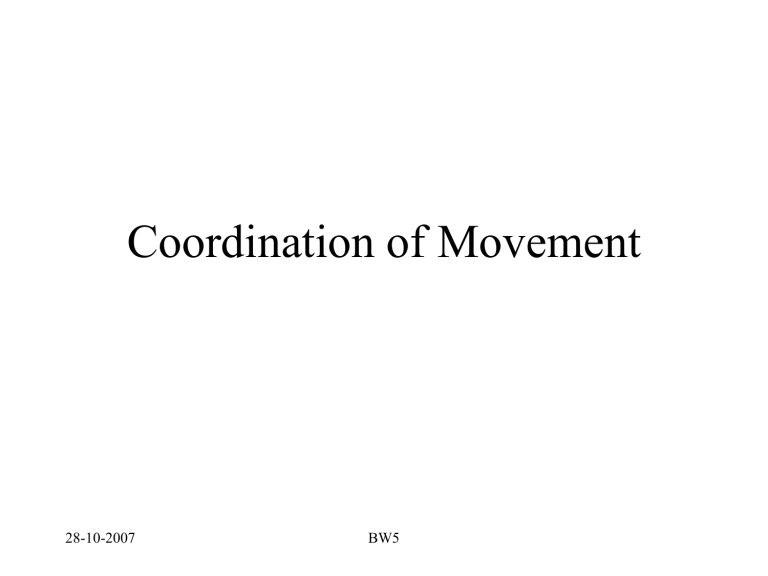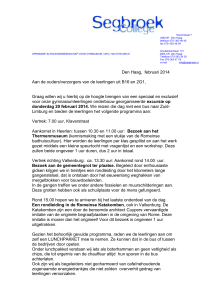
Coordination of Movement
28-10-2007
BW5
Aims
• Insight in coordination of movement
– joints
– muscles
– motor units
• Redundancy (“abundancy”)
– joints
– muscles
– motor units
28-10-2007
BW5
Muscle
architecture
28-10-2007
BW5
Active and passive muscle force varies
as a function of muscle length
28-10-2007
BW5
The motor unit consists of the
motoneuron, its axon and all the muscle
fibers it innervates
28-10-2007
BW5
A single motoneuron innervates
many muscle fibers
• PN16040.JPG
28-10-2007
BW5
Quantitative relationships between
motor neurons and muscle
• Each muscle fiber innervated by a
single motor neuron
• Each motor neuron innervates 10 to
500 muscle fibers
• All muscle fibers in a given motor unit
contract together- not independently
28-10-2007
BW5
Increasing activation frequency
elevates force of contraction
28-10-2007
BW5
Three types of motor units: Type S;
Type FR; Type FF
S=Slow, FR = Fatigue Resistant, FF = Fast Fatiguable
28-10-2007
BW5
Motor unit physiology
•
•
•
•
Twitch and tetanic contraction
Slow and fast twitch motor units: Type S and Type F
Weak and strong motor units
Fatigue resistant (Type FR, Type S) and fatigable
motor units (Type FF)
• Type S are weak and slow but fatigue resistant
• Type FF are strong and fast but fatigable
• Type FR are of intermediate strength, fast and fatigue
resistant
28-10-2007
BW5
Tetanic tension is an inverse
function of contraction time
28-10-2007
BW5
Motor unit activatie
28-10-2007
BW5
Types of motor units
• recruitment threshold
low-high
• Twitch amplitude:
small-large
• Twitch duration: long short
• no/yes fatigable
• red/white muscle
fibers
28-10-2007
BW5
Recruitment order occurs in order of
contraction strength: the Size Principle
28-10-2007
BW5
Recruitment of Motor Neurons in the Cat
Medial Gastocnemius Muscle Under Different
Behavioral Conditions
28-10-2007
BW5
Summary
• Each muscle contains different types of
motor units, that differ in
– recruitment threshold
– fatigable
– twitch duration and amplitude
28-10-2007
BW5
Coordination of movement
Redundancy (“abundancy”)
• joints
• muscles
• motor units
28-10-2007
BW5
Redundantie van spieren
•Over elk gewricht werken meerdere
spieren
•spieren werken over meerdere
gewrichten of dragen bij aan
meerdere bewegings vrijheidsgraden.
28-10-2007
BW5
Motor unit activatie
28-10-2007
BW5
Recruitment van motor units
28-10-2007
BW5
Recruitment van motor units in
biceps
28-10-2007
BW5
Recruitment in biceps
28-10-2007
BW5
Meerdere groepen
motor unit gedrag
in Biceps
Biceps draagt bij aan flexie en
supinatie en bezit aparte motor unit
populaties, die bij die taken actief
zijn.
28-10-2007
BW5
Motor units met verschillend
gedrag liggen in verschillende
delen van de Biceps
S
F
28-10-2007
BW5
Innervatie biceps
28-10-2007
BW5
Conclusions
• Motor units in 1 spier can reveal a different recruitment pattern due to
a different activation.
• The different activation of motor units in a muscle reflect a neuronal
component, not differences in mechanical effects.
• Motor units with the same recruitment behaviour are localized in the
same muscle part : compartimentalisation.
• Within each group of motor units there are motor units with a low and
high recruitment threshold.
• Not muscles, but groups of motor units are the basic elements of
motor activation patterns.
28-10-2007
BW5
Motor units in m. brachialis
Minder activatie bij
supinatie, omdat
biceps meer doet bij
supinatie !
28-10-2007
BW5
Motor Unit gedrag in Triceps
Hoewel triceps een pure
extensor spier is, is triceps
actief bij supinatie en
pronatie om te
compenseren voor
activiteit van biceps en
pronator teres.
28-10-2007
BW5
Conclusies
• Motor units in 1 spier can reveal a different recruitment pattern due to a
different activation.
• The different activation of motor units in a muscle reflect a neuronal
component, not differences in mechanical effects.
• Motor units with the same recruitment behaviour are localized in the same
muscle part : compartimentalisation.
• Within each group of motor units there are motor units with a low and
high recruitment threshold.
• Not muscles, but groups of motor units are the basic elements of motor
activation patterns.
• The activation of a muscle cannot be understood from the
anatomy of that single muscle. The anatomy of the complete
motor system acting across a joint should be considered.
28-10-2007
BW5
Motor-unit gedrag bij reflexen
Reflexen zijn gecoordineerde
responsies. Van groot
belang bij
• lopen in mul zand
• lopen op ongelijk terrein
• bewegen van objecten met
onbekend gewicht.
• “sherry-glass reflex”
28-10-2007
Reflex componenten
• short-latency reflex of
mono-synaptische reflex.
• Long-loop reflex
• Triggered reactions
BW5
Reflexen
Motor
Cortex
Reflex latency:
•mono-synaptisch: 25 ms
(armspieren), 45 ms
(beenspieren)
28-10-2007
BW5
•long-loop: 55 ms
(armspieren), 90 ms
(beenspieren).
Reflex activiteit (triceps)
Mono-synaptisch
Long-Loop reflex
28-10-2007
BW5
Motor-unit activiteit bij reflexen in
triceps
28-10-2007
BW5
Conclusies tav reflexen:
• De monosynaptische reflex treedt alleen op bij
spierverlengingen
• De “long-latency reflex” treedt ook op bij spieren, die niet
in lengte veranderen, maar waarvan de activatie nodig is
om een compensatiekracht in de juiste richting te kunnen
genereren.
• Mono-synaptische reflex compenseert voor wegvallen van
kracht tgv breken van “actine-myosine” filamenten.
• Long-loop reflex zorgt voor gecoordineerde reactie.
28-10-2007
BW5
Samenvatting motor-unit gedrag
• Verschillende typen motor units in een spier
– lage/hoge drempel.
– verschillende groepen motor units met verschillende
activatie.
• Een goed inzicht in de activatie van een spier kan alleen
worden verkregen door meten van motor-unit
activiteit. Oppervlakte EMG is niet voldoende.
• Inzicht in de rol van motor units bij coordinatie vergt
kennis over de anatomie van alle spieren die over een
gewricht werken.
28-10-2007
BW5
Coordinatie van bewegingen
Redundantie (“abundancy”)
• gewrichten
• spieren
• motor units
28-10-2007
BW5
Spieractiviteit voor kracht in
verschillende richtingen
28-10-2007
BW5
Relatie recruitment drempel-EMG
Motor unit gedrag
28-10-2007
BW5
Opp.EMG
Recruitment-EMG
Motor Unit gedrag
28-10-2007
Opp. EMG
BW5
Relatie recruitment-EMG voor arm spieren
28-10-2007
BW5
Activatie brachialis bij
bewegingen tegen een kracht
28-10-2007
BW5
Activatie brachialis bij bewegingen en
krachten in verschillende richtingen
28-10-2007
BW5
Activatie biceps bij bewegingen en krachten
in verschillende richtingen
28-10-2007
BW5
Activatie triceps bij bewegingen en krachten
in verschillende richtingen
28-10-2007
BW5
Mono- en bi-articulaire spieren.
• Mono-articulaire spieren hebben een
voorkeursrichting, die niet afhangt van de
externe kracht en bewegingsrichting.
• Bi-articulaire spieren hebben geen
voorkeursrichting. De activiteit hangt alleen
af van externe kracht.
28-10-2007
BW5
Verkortingssnelheid is relevant !
Brachialis
(mono-articulair)
Biceps
(bi-articulair)
28-10-2007
BW5
Samenvatting
• Mono-articulaire spieren zijn vooral actief
in bewegingsrichtingen waarbij de spier
maximaal verkort.
• Bi-articulaire spieren hebben geen
duidelijke voorkeursrichting.
28-10-2007
BW5
Arbeid, geleverd door de arm
r1
T2
F
r2
3
T1
28-10-2007
BW5
Voorbeelden van negatieve arbeid
28-10-2007
BW5
Voorbeelden van negatieve arbeid
28-10-2007
BW5
Voorbeelden van negatieve arbeid
28-10-2007
BW5
Man-made voertuig
28-10-2007
BW5
28-10-2007
BW5
Muscle force depends on velocity
of lengthening and contraction
28-10-2007
BW5










